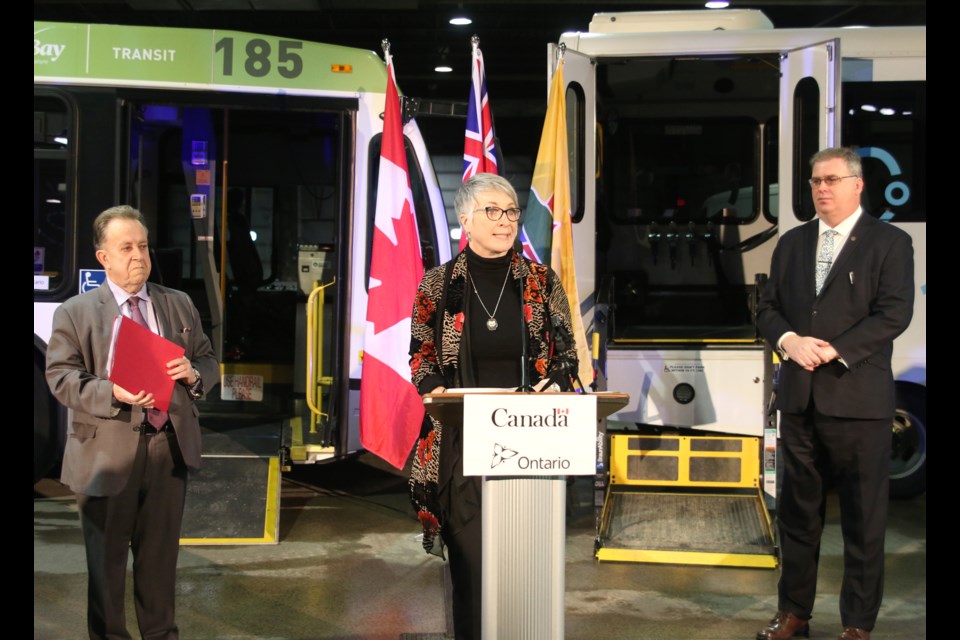THUNDER BAY - Public transit and active transportation users in the city of Thunder Bay can expect to see some improvements to services in the coming year.
On Monday, the federal government announced $6 million for 21 local public infrastructure projects as part of the Public Transit Infrastructure Fund.
“It’s extraordinarily helpful,” said Thunder Bay city manager, Norm Gale. “It does help with the experience and service that we provide, but on a financial side, it’s a boon. The municipalities do rely on the federal and provincial government for assistance to provide these programs and we are grateful for the funding.”
In April 2016, Prime Minister Justin Trudeau announced in Thunder Bay a $3.4-billion investment in public transit projects across the country, though no specific details were given for Thunder Bay.
The $6 million will cover 50 per cent of project costs that range from fleet renewal to pedestrian crossovers. The rest of the funding will come from the City of Thunder Bay through the capital budget, which includes gas tax contributions from the province.
“Municipalities are stretched to the limit, like most of us in various levels of government,” said Patty Hajdu, minister of employment, workforce development, and labour during the announcement on Monday.
“There is a real competition for public dollars. Municipalities are looking for ways to balance that and when they have the support of the federal government to actually meet those needs and make sure they are able to invest in, for example, a fleet that perhaps is less harmful environmentally, that is more accessible, these are things that are going to benefit the community tremendously.”
Some of the public transit projects being funded include $3.7 million for transit fleet renewal that will see 12 conventional buses and 12 specialized vans added to the city transit fleet, $200,000 for upgrading the city hall transit hub, $150,000 for a study for a new centralized transit terminal, and $170,000 for accessible bus stop improvements and shelter upgrades.
Brad Loroff, manager of transit with the city of Thunder Bay, said he funding has allowed transit services to accelerative strategic projects that have been sitting on the shelf and waiting for funding.
“It’s funding that we wouldn’t typically receive,” he said. “You need to invest in public transit to put it in a place to deliver what people need from it.”
According to Loroff, accessibility for transit services is an increasing need among the population, and these investments will help improve accessibility for riders, particularly at bus stops and shelters.
“We have an aging population that relies on transit and it’s that connectivity piece,” he said. “We have an accessible bus system for years from a fleet perspective, but what is lagging behind is on the bus stop infrastructure.”
Expected accessibility improvements include providing hard surfaces at bus stops so transit users are not exiting the vehicles on to grass boulevards. There is also funding set aside to look into Smart Card electronic fare technology. Work on all upcoming projects will begin in April 2017 and are expected to be completed in one year.
The funding for phase one of a study for a centralized transit terminal is part of the city’s transit master plan, Loroff said.
“In that plan, there are some significant recommendations made toward how to make the route network and the service levels of transit better,” he said. “Part of what might be required to support that is the building of a new centralized transfer facility for passengers.”
The study will identify the needs of the community as it relates to a centralized transit hub, which will then be brought back to city council to be moved into phase two.
Of the $6 million being spent, more than $660,000 will be used for active transportation projects that will be completed in the summer of 2017.
These include $103,250 for the Windsor Street active living corridor, $225,000 for the Wardrope active transportation trail, $75,000 for the construction of two new pedestrian crossovers and $55,000 for the construction of a new bike lane.
“Over the past five years, there has been a big shift,” said Adam Krupper, mobility co-ordinator with the city of Thunder Bay. “The provincial and federal government have both stepped up their financial support and also the support in terms of guidelines and regulations in terms of how to build this kind of infrastructure. What that allows us to do is accelerate plans that we thought would take 10 years to make happen. They’re happening now.”
